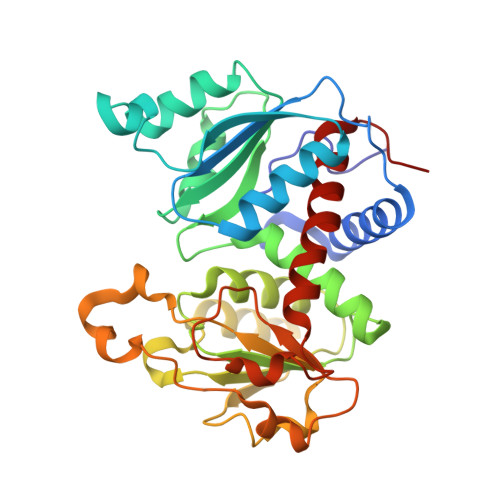Binding of bisubstrate analog promotes large structural changes in the unregulated catalytic trimer of aspartate transcarbamoylase: implications for allosteric regulation induced cell migration.
Endrizzi, J.A., Beernink, P.T., Alber, T., Schachman, H.K.(2000) Proc Natl Acad Sci U S A 97: 5077-5082
- PubMed: 10805770
- DOI: https://doi.org/10.1073/pnas.090087197
- Primary Citation of Related Structures:
1EKX - PubMed Abstract:
A central problem in understanding enzyme regulation is to define the conformational states that account for allosteric changes in catalytic activity. For Escherichia coli aspartate transcarbamoylase (ATCase; EC) the active, relaxed (R state) holoenzyme is generally assumed to be represented by the crystal structure of the complex of the holoenzyme with the bisubstrate analog N-phosphonacetyl-L-aspartate (PALA). It is unclear, however, which conformational differences between the unliganded, inactive, taut (T state) holoenzyme and the PALA complex are attributable to localized effects of inhibitor binding as contrasted to the allosteric transition. To define the conformational changes in the isolated, nonallosteric C trimer resulting from the binding of PALA, we determined the 1.95-A resolution crystal structure of the C trimer-PALA complex. In contrast to the free C trimer, the PALA-bound trimer exhibits approximate threefold symmetry. Conformational changes in the C trimer upon PALA binding include ordering of two active site loops and closure of the hinge relating the N- and C-terminal domains. The C trimer-PALA structure closely resembles the liganded C subunits in the PALA-bound holoenzyme. This similarity suggests that the pronounced hinge closure and other changes promoted by PALA binding to the holoenzyme are stabilized by ligand binding. Consequently, the conformational changes attributable to the allosteric transition of the holoenzyme remain to be defined.
Organizational Affiliation:
Department of Molecular and Cell Biology and Virus Laboratory, University of California, Berkeley, CA 94720-3206, USA.
















